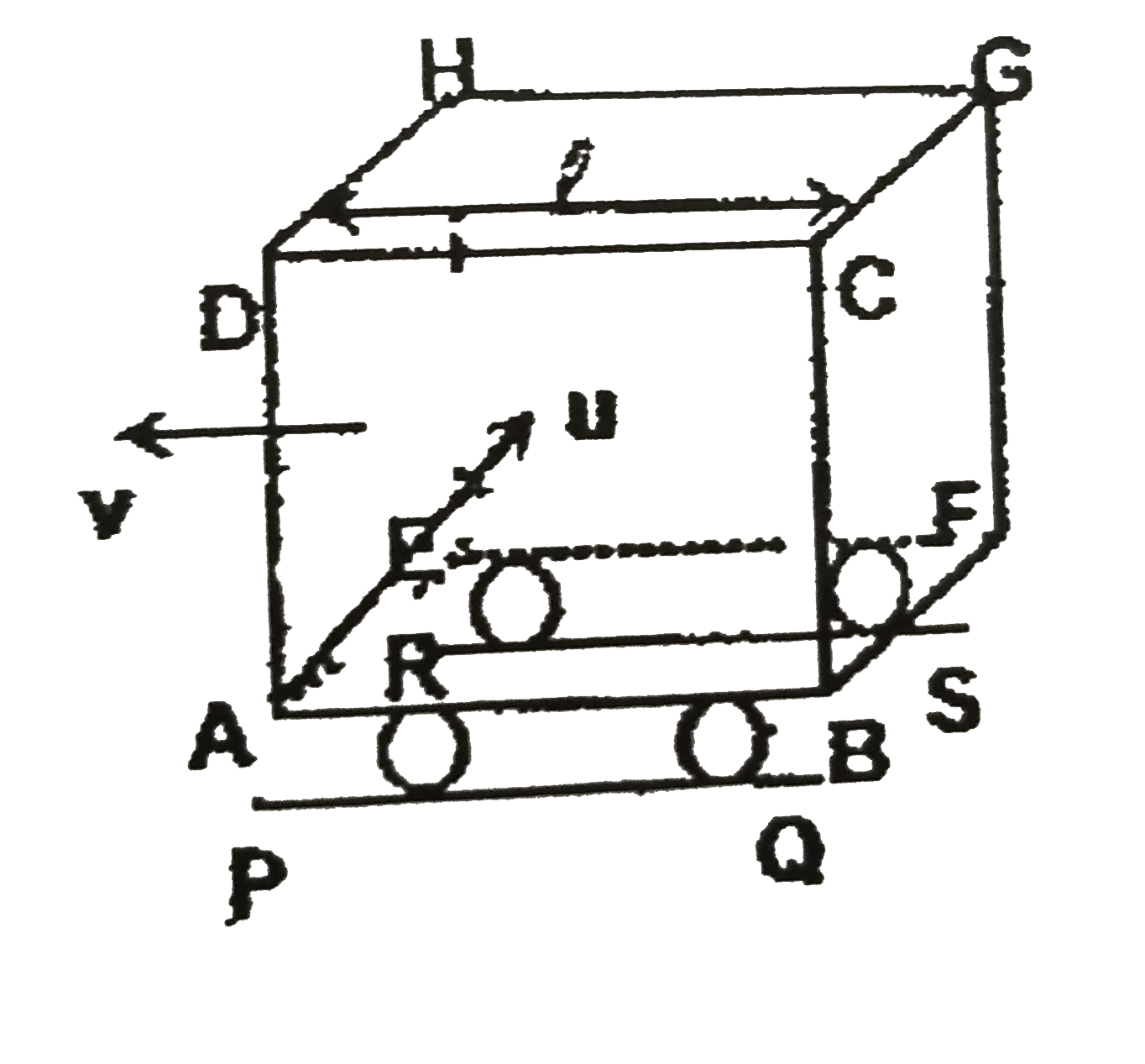Consider the adjacent figure. The cube shaped 0.46 carrage ABCDEFGH of side l has a mass M and it can slide over two frictionless rails PQ and RS. A shot of mass m is thrown from corner A such that it lands at corner F. The angle of projection at seen from the carriage is 45∘. While the shot is in the air. the velocity of carriage as seen from the ground is

m√gl√22(M+m)
m√2gl2(M+m)
m√gl(M+m)
m√2gl(M+m)
Say v is the velocity of carriage w.r.t. ground and u is the velocity of shot w.r.t. carriage as shown in the figure.
u2sin(2×45∘)g=l√2
⇒u=√gl√2 … .(i)
Mv=m[u(cos45∘)×cos(45∘)−v]

⇒(M+m)v=μ2
⇒T_(2)-(T_(1))/(T_(1))=(Deltah)/(h)
Topper's Solved these Questions
- TEST PAPERSBook:BANSALChapter:TEST PAPERSExercise:PHYSICS PART (A)
Explore 32 Videos
- TEST PAPERSBook:BANSALChapter:TEST PAPERSExercise:PHYSICS PART (B)
Explore 3 Videos
- TEST PAPERSBook:BANSALChapter:TEST PAPERSExercise:PHYSICS PART- C
Explore 4 Videos
- SEMICONDUCTORSBook:BANSALChapter:SEMICONDUCTORSExercise:CBSE Question
Explore 32 Videos
Similar Questions
A block of mass m slides along a frictionless surfce as shown in the figure. If it is releases from rest t A what is its speed at B?

View SolutionA particle of mass m is released from rest from a point A of a wedge of mass 4m free to slide on a frictionless horizontal plane.The particle slides down the smooth face AB of the wedge.When the velocity of the wedge is 0.2m/s the velocity of the particle in m/s relative to the wedge is
View Solution
Knowledge Check
A vertical lamp-post of height 9 metres stands at the corner of a rectangular field. The angle of elevation of its top from the farthest corner is 30∘, while from another corner it is 45∘. The area of the field is
A81√2m2B9√2m2C81√3m2D9√3m2A projectile is fired at an angle of 45∘ with the horizontal. Elevation angle of the projection at its highest point as seen from the point of projection is
A60∘Btan−1(12)Ctan−1(√32)D45∘A metallic rod of mass m and resistance R is sliding over the 2 conducting frictionless rails as shown in Fig. An infinitely long wire carries a current I0. The distance of the rails from the wire are b and a respectively.

Find the value of F if the rod slides with constant velocityAμ0I02πR[E+μ0I02πv01n∣∣∣ba∣∣∣]1n(ba)Bμ0I0πR[E−μ0I02πv01n∣∣∣ba∣∣∣]1n(ba)Cμ0I02πR[E−μ0I02πv01n∣∣∣ba∣∣∣]1n(ba)DNone of these
A particle of mass m is released from rest from a point A of a wedge of mass 4m free to slide on a frictionless horizontal plane. The particle slides down the smooth face AB of the wedge. When the velocity of the wedge is 0.2 m/s the velocity of the particle in m/s relative to the wedge is
View SolutionA particle of mass m is released from rest from a point A of a wedge of mass 4m free to slide on a frictionless horizontal plane. The particle slides down the smooth face AB of the wedge. When the velocity of the wedge is 0.2 m/s the velocity of the particle in m/s relative to the wedge is
View SolutionTwo point masses m and M are separated by a distance L . The distance of the centre of mass of the system from m is
View SolutionA metallic rod of mass m and resistance R is sliding over the 2 conducting frictionless rails as shown in Fig. An infinitely long wire carries a current I0. The distance of the rails from the wire are b and a respectively.

Find the value of current in the circuit if the rod slides with constant velocity v0
View SolutionA canon of mass M is mounted on an east west frictionless railway track. The barrel of cannon faces the north east direction at an angle of 45∘ with the vertical. The canon fires a shot of mass M with a speed V relative to the barrel.
View Solution

